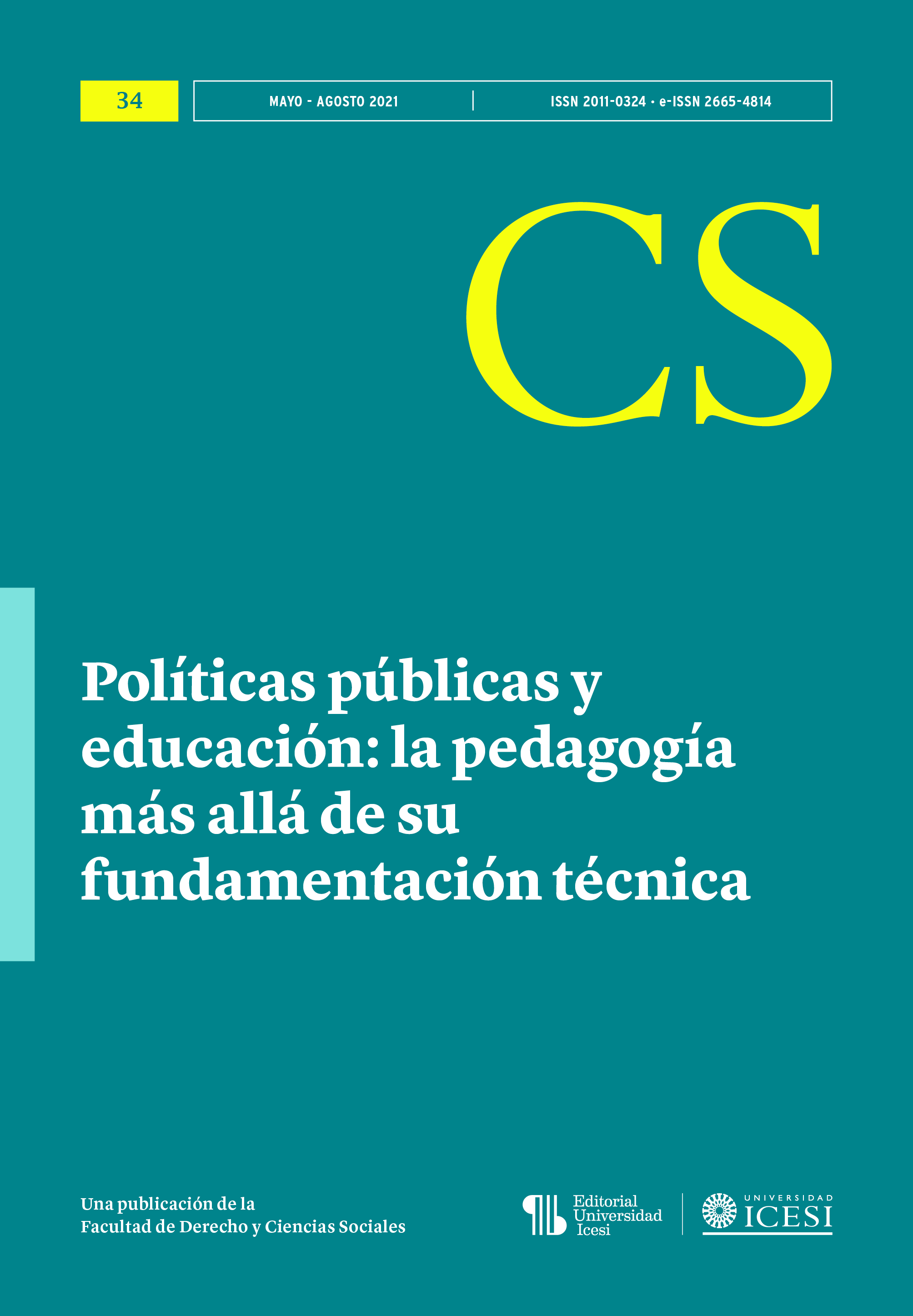Misiones económicas en Colombia y su incidencia en la educación técnica industrial (1930-1960)
DOI:
https://doi.org/10.18046/recs.i34.4193Palabras clave:
desarrollo industrial, enseñanza técnica, relaciones económicas internacionalesResumen
Este artículo establece la contribución de algunas misiones económicas en la educación colombiana entre 1930 y 1960, las cuales siguieron las directrices impartidas por las misiones educativas que, de manera simultánea, arribaron al país. Las fuentes de este artículo son los informes oficiales presentados por las misiones y la normatividad existente apoyada con historiografía, lo cual permite determinar aspectos políticos y económicos de Colombia en diferentes momentos. Las misiones Kemmerer (1923, 1930), Currie (1949-1950) y Lebret (1954-1956) diagnosticaron el acontecer económico y social del país, y determinaron las condiciones para emprender procesos de crecimiento a partir del desarrollo de la educación técnica industrial en sus diferentes niveles, para así cumplir con los requerimientos de políticas externas que promovieron el desarrollo de América Latina, lo cual impulsó la formación técnica industrial y la consolidación del sistema educativo en general.
Descargas
Referencias
Banco Mundial (1950). Bases de un programa de fomento para Colombia. Informe de una misión dirigida por Lauchlin Currie. Bogotá: Banco de la República.
Bejarano, Jesús (1980). La economía en el siglo XX. En Manual de Historia de Colombia (Tomo III, pp. 17-79), editado por Jaime Jaramillo-Uribe. Bogotá: Colcultura.
Carrizosa, Julio (1933). Memoria del ministro de Educación Nacional al Congreso. Bogotá: Cromos.
Castro, José Joaquín (ed.), (1938). Educación Nacional: Informe al Congreso. Bogotá: ABC.
Currie, Lauchlin (1993). Los objetivos del desarrollo. Cuadernos de Economía, 13(18-19), 163-188.
Decreto 1570 de 1939 (2 de agosto), por el cual se fija el plan de estudios de educación secundaria. Diario Oficial núm. 24140. Recuperado en https://www.mineducacion.gov.co/1759/articles-102775_archivo_pdf.pdf
Decreto 2350 de 1939 (7 de diciembre), por el cual se reglamenta la enseñanza industrial. Diario Oficial núm. 24239. Recuperado de http://www.suin-juriscol.gov.co/viewDocument.asp?ruta=Decretos/1439958
Decreto 1385 de 1940 (17 de julio), por lo cual se reglamenta el Decreto 503 de 1940, en lo relativo a construcciones escolares. Diario Oficial núm. 24420. Recuperado de http://www.suin-juriscol.gov.co/viewDocument.asp?id=1277161
Decreto 884 de 1946 (16 de marzo), por el cual se crea el Bachillerato Técnico Industrial y se fija el correspondiente plan de estudios. Diario Oficial núm. 26093. Recuperado de http://www.suin-juriscol.gov.co/viewDocument.asp?ruta=Decretos/1183794
Decreto 2586 de 1950 (6 de agosto), por el cual se crea el Instituto Colombiano de Especialización Técnica en el Exterior. Diario Oficial núm. 27383. Recuperado de https://www.mineducacion.gov.co/1759/articles-103405_archivo_pdf.pdf
Decreto 118 de 1957 (21 de junio), por el cual se decretan aumentos de salarios, se establece el subsidio familiar y se crea el Servicio Nacional de Aprendizaje, SENA. Diario Oficial núm. 29441. Recuperado de http://www2.congreso.gob.pe/sicr/cendocbib/con4_uibd.nsf/38B359B895555A6905257FE20078E2A4/$FILE/1.DECRETO_118_DE_1957_crea.pdf
Decreto 164 de 1957 (6 de agosto), por el cual se organiza el Servicio Nacional de Aprendizaje. Diario Oficial núm. 29475. Recuperado en https://www.redjurista.com/Documents/decreto_164_de_1957_poder_ejecutivo.aspx#/
Decreto 2433 de 1959 (11 de septiembre), por el cual se modifican los planes de estudios para la enseñanza industrial y comercial. Diario Oficial núm. 30076. Recuperado de https://www.mineducacion.gov.co/1759/articles-103600_archivo_pdf.pdf
Desarrollo del proyecto principal de la Unesco sobre educación primaria en Iberoamérica (1960). Revista de Educación, 39(112), 35-39.
Díaz, Ariel; León, Libardo (2008). Historia de una universidad del medio siglo: la Universidad Industrial de Santander. Bucaramanga: UIS.
Gaitán, Jorge Eliécer (1940). Obra educativa del Gobierno en 1940. Bogotá: Imprenta Nacional.
Galán, Mario (2008). Una obra vital para Santander. Revista de Santander, 3, 18-21.
Galán, Gabriel (2011). Mario Galán Gómez: un hombre hecho por sí mismo. Bucaramanga: Universidad Industrial de Santander.
Helg, Aline (2001). La educación en Colombia 1918-1957. Bogotá: Universidad Pedagógica Nacional.
Kemmerer, Edwin (1927). Economic advisory work for governments. The American Economic Review, 17(1), 1-12.
Lebret, Louis-Joseph (1958). Estudio sobre las condiciones del desarrollo de Colombia. Bogotá: Cromos.
Ley 56 de 1927 (10 de noviembre), por el cual se dictan algunas disposiciones sobre instrucción pública. Diario Oficial núm. 20645. Recuperado de https://www.mineducacion.gov.co/1621/articles-102998_archivo_pdf.pdf
Ley 23 de 1931 (9 de febrero), por el cual se crea un Consejo de Economía Nacional. Diario Oficial núm. 21619. Recuperado de http://www.suin-juriscol.gov.co/viewDocument.asp?ruta=Leyes/1578740
Meisel, Adolfo; Ramírez, María Teresa; Jaramillo, Juliana (2014). Muy tarde pero rentables: los ferrocarriles en Colombia durante el periodo 1920-1950. Cuadernos de Historia de Colombia, 34, 1-54.
Melgarejo-Rey, Florentino (1931). Informe del director de Educación al señor gobernador del departamento de Cundinamarca. Bogotá: Imprenta del Departamento.
República de Colombia (1957). Informe del Proyecto para el I Plan Quinquenal. Bogotá: República de Colombia.
Sáenz, Eduardo (2001). La Misión del Banco Mundial en Colombia, el Gobierno de Laureano Gómez (1950-1951) y la Asociación Nacional de Industriales (ANDI). Cuadernos de Economía, 20(35), 245-265.
Sánchez, Raúl (1967). Colombia, Planeamiento de la Educación. París: Unesco.
Valencia-Restrepo, Jorge (1987). La Misión Kemmerer y los intereses financieros británicos en Colombia durante la década de 1920. Lecturas de Economía, 24, 9-53.
Publicado
Número
Sección
Licencia
Derechos de autor 2021 Álvaro Acevedo Tarazona, Dayana Lucía Lizcano Herrera

Esta obra está bajo una licencia internacional Creative Commons Atribución-NoComercial 4.0.
© Derechos reservados de autor
El material de esta publicación puede ser reproducido sin autorización, siempre y cuando se cite el título, el autor y la fuente institucional.
El contenido publicado en Revista CS se distribuye bajo la licencia Creative Commons BY-NC 4.0 Atribución/Reconocimiento-NoComercial 4.0 Internacional.
Usted es libre de:
Compartir — copiar y redistribuir el material en cualquier medio o formato.
Adaptar — remezclar, transformar y construir a partir del material.
Bajo los siguientes términos:
Atribución — Usted debe dar crédito de manera adecuada, brindar un enlace a la licencia, e indicar si se han realizado cambios. Puede hacerlo en cualquier forma razonable, pero no de forma tal que sugiera que usted o su uso tienen el apoyo de la licenciante.
NoComercial — Usted no puede hacer uso del material con propósitos comerciales.












